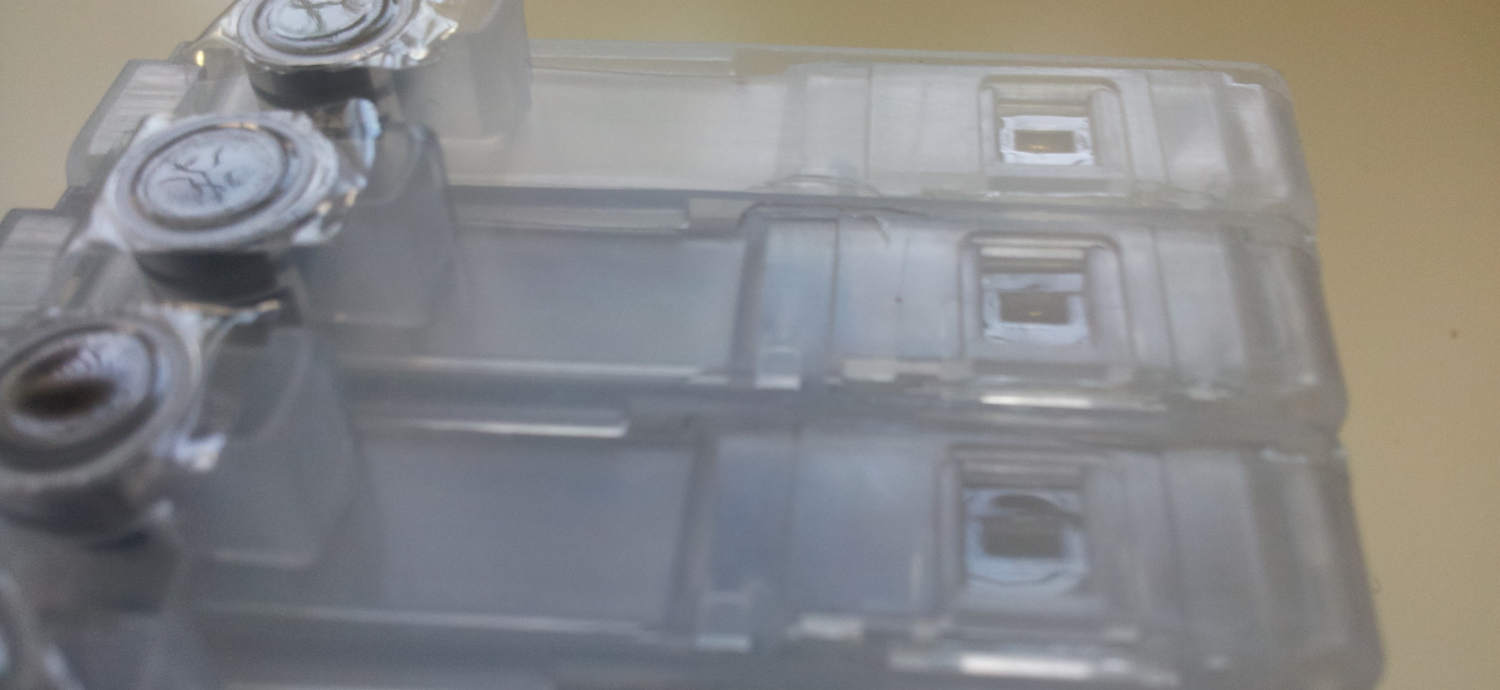How Epson uses Canon / HP solutions in home printers
In the summer of 2012, Epson introduced a new series of home inkjet printers and MFPs of the Expression Home XP series with a mixed type of ink and dual control of dye consumption. Before that, there were series: C / CX, R / RX, T / TX, S / SX, P / PX and L with a simple flow meter and one type of ink: pigmented or water soluble.
What we have already seen in HP / Canon
For the first time in the new series, Epson began to combine inks — the black cartridge for printing text was filled with pigment, the remaining three or four cartridges (for images) with water-based ink. Interestingly, such a “color” set was always used by Canon and HP in their home printers.
What does this give?
')
Another "innovation" line - lenses for additional control of ink levels. That's how they look on refillable cartridges for Expression Home XP.

The lens comes out triangular inside the inkwell. A LED is shining on the bottom of the lens. If it is covered with ink - the light does not fall on the photodetector, the lens is bare - the light is reflected in the photodetector. As a result, the printer informs the user that the ink has completely run out. This is especially convenient when you refill your cartridge, and the main counter (see below) has long understood nothing.
This backup control system is used in conjunction with the software ink consumption counter, which, using specified algorithms, calculates how much dye has been consumed and relates this data to the cartridge type in the chip (standard, XL, etc. - this reflects the volume). If the counter "thinks" that the ink is at zero - work with this cartridge (read by the chip) is blocked - therefore refilling the original cartridges is useless. And this also causes the need to reset the chips on non-original consumables - CISS, PZK, etc. - with a button, pulling out or resetter.
It must be said that only the joint operation of two algorithms ensures reliable operation - the lens does not always work, and ink consumption is considered not always accurate.
In general, the changes are positive, but not for all users. I used to have the opportunity to buy cheap inkjet printers with the ability to use CISS and pigment (or sublimation ink) for printing micro-runs of leaflets. And now not. According to user feedback, new 4-flower beds with a combined type of ink, translated completely into pigment or sublimation, have to be cleaned a lot.
What we have already seen in HP / Canon
For the first time in the new series, Epson began to combine inks — the black cartridge for printing text was filled with pigment, the remaining three or four cartridges (for images) with water-based ink. Interestingly, such a “color” set was always used by Canon and HP in their home printers.
What does this give?
- Savings on ink (with the same amount of water cheaper), though only for Epson (for the user, the price per milliliter only grows - the volume of cartridges is less, the retail price does not change much)
- Ease of use for the user - now in 4-color printers color ink in the print head dries less
- There was a simple opportunity to reduce the size of the drop for color inks, and therefore increase the print resolution. The fact is that the usual “budget” pigment can clog narrow channels of nozzles, so the resolution on 4-color Epson “pigment” printers was lower than on 6-color pigments, which only worked on aqueous dyes.
')
Another "innovation" line - lenses for additional control of ink levels. That's how they look on refillable cartridges for Expression Home XP.

The lens comes out triangular inside the inkwell. A LED is shining on the bottom of the lens. If it is covered with ink - the light does not fall on the photodetector, the lens is bare - the light is reflected in the photodetector. As a result, the printer informs the user that the ink has completely run out. This is especially convenient when you refill your cartridge, and the main counter (see below) has long understood nothing.
This backup control system is used in conjunction with the software ink consumption counter, which, using specified algorithms, calculates how much dye has been consumed and relates this data to the cartridge type in the chip (standard, XL, etc. - this reflects the volume). If the counter "thinks" that the ink is at zero - work with this cartridge (read by the chip) is blocked - therefore refilling the original cartridges is useless. And this also causes the need to reset the chips on non-original consumables - CISS, PZK, etc. - with a button, pulling out or resetter.
It must be said that only the joint operation of two algorithms ensures reliable operation - the lens does not always work, and ink consumption is considered not always accurate.
I like only partly
In general, the changes are positive, but not for all users. I used to have the opportunity to buy cheap inkjet printers with the ability to use CISS and pigment (or sublimation ink) for printing micro-runs of leaflets. And now not. According to user feedback, new 4-flower beds with a combined type of ink, translated completely into pigment or sublimation, have to be cleaned a lot.
Source: https://habr.com/ru/post/177969/
All Articles